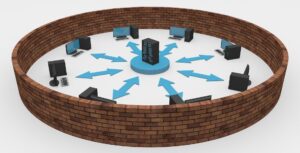
Pivot: How the Wildfires are Changing the LA Region
Just as the COVID-19 pandemic reordered the world, so will the LA fires upend Los Angeles and its industrial base. The flames themselves destroyed great swaths of public and privately owned real estate, which may or may not be rebuilt. Beyond the burn zones, smoke and wind influences in far-flung agricultural communities have damaged crops; the economic value of those losses is yet to be determined. Further, many regional supply chains and industrial systems that have survived the fires may experience higher demand for goods and services without the means to respond directly to those requests.
In short, the damage caused by the fires impacts more than just the property owners who’ve lost their homes and businesses. Damages have also been suffered by the city, the county, and all of the Southern California region. Governments, industrial leaders, and companies must now assess where the failures and damages occurred and determine whether to mend or repair them or simply rebuild anew.
Immediate Known Losses. Longterm Uncertainties.
Real Property Losses
The immediate real property loss estimates caused by the fires encompass a myriad of real estate assets:
• Approximately 16,000 homes and business buildings were destroyed.
• The median value of each of these destroyed properties is estimated at $2.09 million.
• Multiplying that figure by a ratio of 2.2, the ‘insured capital’ value (as determined by insurance figures derived from previous fire disasters) puts the estimated aggregate real property loss in the region at ~$74 billion.
These figures apply solely to the buildings that were destroyed during the crisis and may not reflect the total loss to property owners. In some cases, insurance values may be lower or homeowners may have eschewed insurance altogether. In other cases, insurance companies may have dropped coverage for properties in these areas due to heightened risk of loss or damage by any cause, leaving owners with no financial recourse at all. In either of those instances, home and property owners may not collect the full value of their losses.
Ancillary Losses
Other figures suggest a more overarching ‘loss map,’ one that includes the fire’s impact on industrial and public resources, as well as on the community’s health.
Agriculture
California is the country’s top agricultural producer, accounting for as much as 11% of the nation’s aggregate annual output. However, on a smaller scale in terms of actual product, the LA region accounts for a larger percentage of the national food supply, depending on the crop:
• It annually delivers 27% of the country’s fruit supply, including citrus, apples, etc.
• It also provides 24% of the nation’s vegetable production, and
• almost 20% (19%) of the nuts grown in the U.S.
The nine regional counties responsible for the annual and food cash infusions into national coffers are also the most affected by the fires. Los Angeles, Monterey, Kern, Orange, San Bernardino, Riverside, Ventura, Santa Barbara, and San Luis Obispo counties have all experienced adverse effects from the disaster, either directly by fire or indirectly by smoke or ash or both. Smoke from the flames has tainted thousands of acres of agricultural land in the nine most affected counties, devastating this year’s yield. At the same time, ash falling across fields and acreage is tainting the soil, which will affect crop quality for at least another year or more.
In addition to the loss of agricultural resources, many of the ~86,000 agricultural workers are also impacted as their livelihoods literally ‘go up in smoke.’ The aggregate contribution to California’s Gross Domestic Product (GDP) of both agricultural labor and crop production is $10.8 Billion, plus another $9.2 billion contributed by related supply chain industries. The abrupt cessation of agricultural industry activities will significantly impact the state’s budget as a whole.
Supply Chains
Fortunately, no major industrial warehouses were destroyed by the wildfires, although some lost power for a period to reduce the risk of igniting more. However, the extent of the loss of physical and real property suggests that the supply chains that fill those warehouses will suffer significant strains as communities begin their rebuilding processes. And those strains may appear sooner rather than later as communities work to resume their lives amidst the ruins:
• Retail stores (grocery, apparel, home goods) may experience excessive runs on their wares as displaced populations travel in search of resources they’d lost in the fires.
• Building supply stores will almost certainly have to expand their volume of goods as neighborhoods begin the actual rebuilding process.
• Logistics suppliers will also experience higher than usual call volumes as both individuals and companies reach out to replace supplies and goods that were either lost or have already been snapped up.
These phenomena will require attention and resources as the Southern California region moves toward recovery.
Public Health
An additional collateral impact on the LA region caused by the wildfires is that of smoke on the human body. The Environmental Protection Agency (EPA) tracks how various populations are affected by wildfire smoke and uses the data to measure the impacts on health rates in affected communities. The EPA uses an Air Quality Index (AQI) to determine the relative quality of the nation’s air and associates those data with human health impacts and outcomes. According to their research, while inhaling wildfire smoke is bad for everyone, some populations will suffer more – and longer – after being exposed to toxins like those recently released in LA County:
• The wildfire smoke is more challenging for younger and older people. Children can be particularly sensitive; their bodies are inherently more vulnerable and they are often outdoors much more than grown-ups.
• Older adults (middle-aged and beyond) also tend to suffer more significantly from smoke inhalation. Often, there are pre-existing conditions that impair lung and heart functions, both of which absorb much of the brunt of the smoke damage.
• Sick people are often made more sick when exposed to toxic smoke and fumes. Those with cardiovascular conditions such as high blood pressure, coronary artery disease, and cerebrovascular conditions frequently experience additional symptoms when inhaling smoke-tainted air, such as heart palpitations, lightheadedness, and shortness of breath.
Pregnant women, outdoor workers, and those of lower socioeconomic standings are also among individual groups that suffer more egregious injuries when exposed to toxic environmental conditions like wildfire smoke.
It’s been just a few weeks since the fires were contained, and, in many cases, assessments for damages haven’t yet begun. As they commence, they will certainly reveal not just immediate concerns but also circumstances that will have a more prolonged, more profound impact on the greater community. As the region moves into the ‘assess and address’ phase, that emerging data will reveal just how much the fires cost directly, in terms of actual losses, and will cost in terms of rebuilding and recovery expenses.


